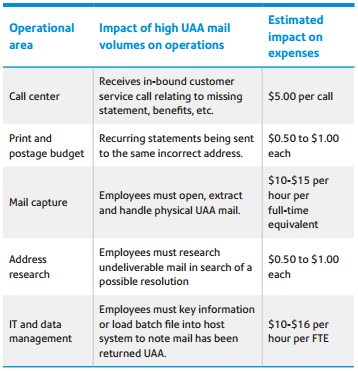The statement that the cost of undeliverable mail has gone up at first seems hard to believe. How can costs be rising? If you’re a mailer, printer, or mail service provider (MSP), it’s likely you’ve done everything you can in recent years to reduce your undeliverable mail by implementing every solution in the book, the full range of acronyms, from CASS, NCOALink and ACS, to AECI and AECII.
Yet in 2016, overall Undeliverable-as-Addressed (UAA) mail did in fact increase. More than 6.8 billion pieces of mail were undeliverable — that’s 4.56% of outbound volume. And the cost to the United States Postal Service (USPS) to process all that UAA mail was a whopping $1.3 billion. This is even more alarming, given the fact that overall mail volume decreased last year.
You can glean some useful information if you look at UAA by class of mail. First Class Mail is the most expensive to process, because pieces are forwarded or returned to the sender if the name and address is UAA. USPS stats show that in 2016, First Class mail volume decreased by 2.2%, while First Class UAA volume decreased by 1.7%. But the cost per piece for the USPS to manage First Class UAA mail increased:
· 2015 - $0.328 per piece
· 2016 - $0.332 per piece
The good news is that the USPS is being very transparent about UAA and about the impact that it has not only on its operations, but also on some specific vertical industries, such as finance, insurance, and government. See the latest stats, published by industry, at: https://postalpro.usps.com/address-quality-solutions/undeliverable-addressed-uaa-mail
Why Are Costs Going Up?
In this article, we’ll focus on three industry trends that are causing the cost of UAA mail to continue heading upward:
· continued low hanging fruit issues;
· addressing issues becoming more complex;
· more government agencies getting involved in regulating address quality.
Low Hanging Fruit
These issues include simple addressing problems, such as address formatting issues and common street misspellings. As these challenges continue, costs mount. Industry experts have shown that just the operational cost of undeliverable mail ranges from $1 to $3. ROI calculators available from reputable vendors can individualize the cost for your company. For example:

The good news is, by cleaning up these simple addressing problems (the low hanging fruit) you will see a measurable reduction in return mail. In evaluating a system, most reputable vendors will run a proof of concept for you to confirm that their solution will deliver the expected results. But what do you do when the address is flagged as “vacant”? According to January 2017 stats, 43% of undeliverable mail for the government vertical was vacant. These complicated address issues will take more time to research and correct.
Complex Solutions
Data and the way it is managed have changed dramatically. Think about the following:
· Where do you store your own personal addresses today?
· Are you using an online contact book?
· When was the last time you synced your contact book with your mailing data?
· How many databases did your company have five years ago?
· How many does it have today?
· Where is all your company’s data stored now?
· Have you ever discovered a mailing address that does not physically exist?
· Do your systems flag records in which the mailing address does not match the physical location of the recipient?
These questions were not asked five to 10 years ago, but they need to be voiced today. That’s because the amount of data available to us now is exponentially larger. Solutions need to be more complex because the data is more complex. Technology has reached a point where we’re even performing more complex measurements. In addition to describing various aspects of a data set, we can now also define the relationship between two completely unique data sets. For example, we are able to measure the relationship between a mailing address and a physical location. This type of matching has been done for years by governments to establish tax jurisdictions, and now mailers can also use geodata to confirm whether a mailing address is truly deliverable.
More Government Agencies Regulating Address Quality
While the USPS is the recognized standard for address record integrity, multiple governing agencies are starting to oversee name and address information. Therefore, the data generated in returned mail is becoming more valuable to a company:
· Returned mail data is a trigger that something is wrong with the communication process. Since communications are not being received, the company may be in jeopardy of violating government regulations.
· The data on returned mail can also be used to repair a customer record, thereby fixing the communication process and mitigating the impact regulations could have had on a company.

Here is an example of how these government regulations operate. The SEC Rule 17AD-17 was designed to reduce the number of lost security holders (for example, beneficiaries that do not claim life insurance policies). A security holder is considered “lost” if any correspondence from a broker, dealer, or transfer agent is returned by the USPS because of an undeliverable address. When a piece of mail is returned, the mailer is required to take these actions:
· the mailer has a one-time option to re-mail before flagging the security-holder as “lost;”
· if the record cannot be updated within a specified timeframe (from a few days up to three months), the company is required to send the recipient’s name and SSN to a third party to try and obtain address updates.
For full details on SEC17AD-17 please visit – http://sec.gov/rules/final/2013/34-68668.pdf
Regulations governing how we deliver communications to our customer will likely increase, not decrease. But, this complexity gives us all an opening to innovate, to do something unique and automated. New measurements can provide more accurate ROI and indicate ways to improve the customer experience by making sure messages are getting delivered.
For more information on this subject, please join our webinar on June 11th hosted by Pitney Bowes in partnership with Mailing Systems Technology, “Turn the Negative Impact of Returned Mail Into a Positive One.” And if you're reading this article after the fact, no problem; Mailing Systems Technology's webinars are archived for a full year after the air date, so you can still view the presentation through this link.
Next month, we’ll publish a follow up article in this space covering the the pros and cons of available solutions to help reduce the overall costs for misaddressed, undeliverable mail, including best practices for measuring the effectiveness of your address cleansing efforts.











